The Future of Marketing Automation with Andrew Parker
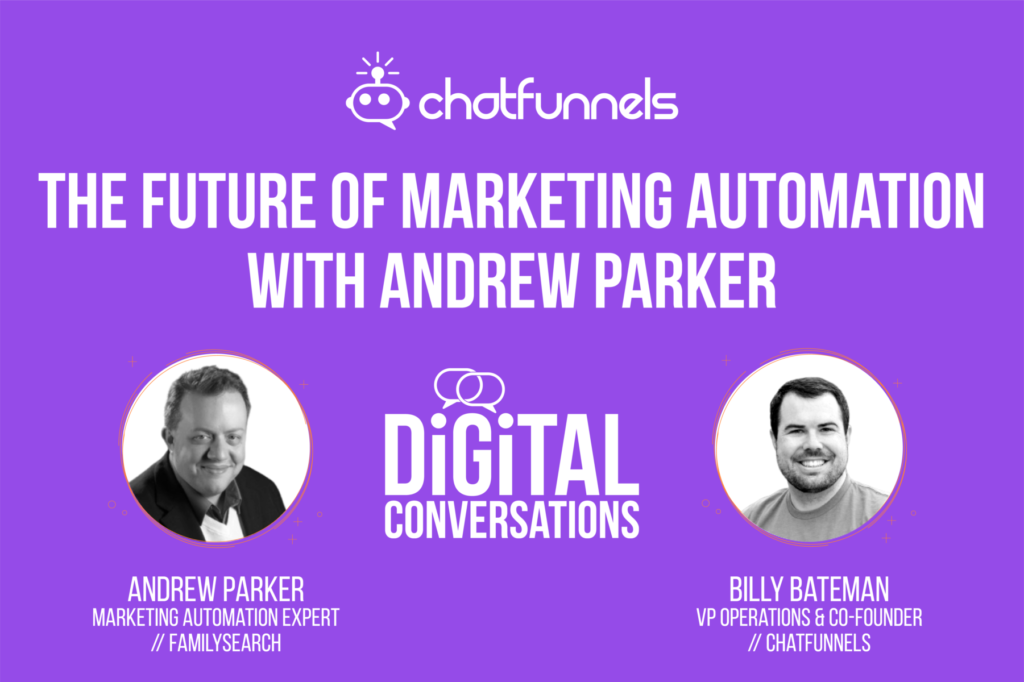
Reading Time: 15 minutes
Overview: This week on digital conversations with Billy Bateman our guest is Andrew Parker, marketing executive at Family Search. They discuss the future of marketing automation and the best technology stack for you business.
Guest: Andrew Parker – Mr. Parker is an accomplished marketing executive who has successfully helped companies tell their story, build an audience and scale their impact. His talents have resulted in success for numerous companies including small, medium and large scale enterprises. And with a depth of experience in both B2B and B2C marketing, Mr. Parker stands out as a marketing executive who understands how to develop and execute a marketing strategy that will drive results.
Reference:
Reading Time: 15 minutes
Guest: Andrew Parker – Mr. Parker is an accomplished marketing executive who has successfully helped companies tell their story, build an audience and scale their impact. His talents have resulted in success for numerous companies including small, medium and large scale enterprises. And with a depth of experience in both B2B and B2C marketing, Mr. Parker stands out as a marketing executive who understands how to develop and execute a marketing strategy that will drive results.
Overview: This week on digital conversations with Billy Bateman our guest is Andrew Parker, marketing executive at Family Search. They discuss the future of marketing automation and the best technology stack for you business.
Reference:
Transcript
Billy All right, everyone, welcome to Digital Conversations. For this episode we’re lucky to have Andrew Parker, marketing automation expert with us. Andrew, thanks for joining us.
Andrew Thanks, Billy. Thanks for inviting me. Really happy to be here.
Billy Glad you could come on and talk, marketing automation is going be our topic today. And before we hop into it, just tell us a little bit about yourself and your background and journey in marketing.
Andrew I’m currently working for Family Search International, which is the world’s largest genealogy company in the world. We’re actually a non-profit, as opposed to Ancestry, which is a for-profit company, but we partner with them quite closely. And I’ve been here for about two years and I help to oversee a lot of the marketing automation initiatives that we’re undertaking.
Prior to this role, I was the chief marketing officer for the Leonardo Museum in Salt Lake City. So I got to launch all sorts of fun exhibits and meet some really cool and famous people. That was a lot of fun and then I worked for several other companies prior to that.
I did spend about ten years working for a company called Axis Development, where I learned my chops or have my teeth on marketing, where I learned how to do email marketing and Google AdWords and some SEO and copywriting and all that other good stuff. Did that for almost ten years or so. And ever since then, I’ve just taken those lessons that apply to different industries and different organizations with ever-increasing levels of success. So it’s been a good journey.
Billy Interesting journey. And then you’re also an adjunct professor. That’s correct. Right?
Andrew Yeah. So I teach at the LDS Business College here in Salt Lake City and I teach digital marketing there. And so everything from last semester was Google AdWords and search engine optimization. And then the semester before that was social media marketing strategy. Semester before that was website development strategy. I got a chance to teach a lot of different subjects, but I’ve had such a wide-ranging experience when it comes to marketing.
I’ve been able to be both a kind of a breadth and depth guy with all the different parts of marketing. So it’s really kind of fun to go and teach the kids. Most of them are international. They’re from outside the United States. So we get the majority of our students there. And they really come into the digital marketing program. They’re at the LDSBC, really eager to learn because marketing, especially social media and online marketing is such a big part of their lives that outside of America.
Billy Maybe we should call you Professor Parker for the rest of this.
Andrew Only if I get to wear a white coat.
Billy You can wear whatever you want. I’m sure that’s awesome for the students to have somebody that’s actually done their craft. I know when I was in college, I loved my professors that were more on the adjunct side. And that they’re working because they could tell us here’s what’s actually going on, as opposed to here’s what happened ten or twenty years ago.
Andrew It makes a big difference for me. I’ll tell you the selfish reason I took the gig was because it forces me to stay up to date on stuff. Not that I don’t enjoy reading or understanding blog posts or going to webinars or conferences, those kinds of things. But when you have to teach somebody about the latest trends in social media marketing, it really forces you to keep on, keep on your toes. And so that’s the ultra-selfish reason I do it.
Background
Billy Well, it’s awesome. I’m glad you’re doing that. I got one more question for you before we jump into the meat of this, I ask everybody if we’re going to look up Professor Parker on LinkedIn, Facebook, or Twitter and try to figure out who you are, what’s something we would not know about you from doing a little social snooping?
Andrew Well, so back in high school, I had a job working for a company called Sculpture’s Software, and they were the developers behind Mortal Kombat 3. And I was on the testing crew for Mortal Kombat 3. So if you actually Google my name in Mortal Kombat 3, you’ll notice that I’m on the credits for the game as a tester. For two months I played nothing but Mortal Kombat 3 every day for eight hours. I got paid to do it, which was the greatest job in the history of being a teenager.
Billy I’m sure, man, I’m pretty jealous. I had bought Mortal Kombat two, without my mother knowing because she would not have allowed that. And kept it for almost a year until my youngest brother figured out where we kept it and pulled it out while we were at school, started playing it and there was hell to pay when we came home that day from school.
Andrew I bet. Well, my mother when she found out that that’s what I was testing- she’s like, you have to quit that job immediately. No, I don’t. But that’s just kind of ignited a lifelong love of video games for me. So I’m a giant gamer. I love it. Mostly a Nintendo fan. So I like Zelda. Mario, Fire Emblem, all that good stuff.
Marketing Automation
Billy Well, we’ve had enough patty cake. Let’s jump right into it. I want to start off and ask you, because we were talking about this before the call and let’s just jump into this. Marketing automation, a lot of people, when you bring it up, they think email automation and email marketing.
So and you have a very different opinion that it’s not email. And I tend to agree with you. So if you were going to define marketing automation and how it’s different, how would you do that?
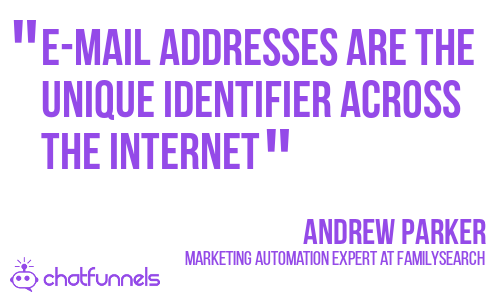
Andrew Email marketing is kind of in a lot of ways the backbone of digital marketing these days? And not because we just send out spam messages wherever and whenever, but e-mail addresses are the unique identifier across the Internet.
You use it to log into everything from your bank to your Door dash order or whatever it is. And so e-mail powers look like audiences on Facebook and Google. Certainly there’s been you know, there are all sorts of talking around marketing automation when it comes to e-mail sequences. You fill out a form and you get an e-mail sequence.
But marketing automation is more along the lines of taking all of the different digital channels that are out there and even some of the offline channels as well and integrating them into a holistic customer experience.
So e-mail plays a part in that, you can automate when e-mails go out and to whom and where and when. You can customize the content as well. But you can do all of those same things with landing pages, with Google ads, with Facebook posts, with your Web site. Even there’s a company here in Salt Lake called Flip Billboards that allows you to do some integration with marketing automation.
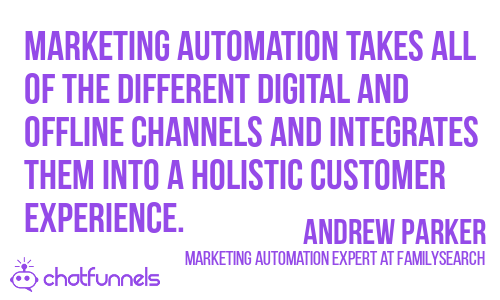
You can even enter integrate with direct mail so that you get a very personalized direct mail experience for people tied to their online email or website experience. Marketing automation is less about just doing email sequences. That’s what everybody thinks about. It’s really about truly developing a customer experience that’s going to take somebody from the top of the funnel all the way to the bottom of the funnel and to rapidly increase the pace of them coming through that funnel so that they come through it quickly, they convert quickly, and then they become more loyal after they convert as well. So that’s the way I would hope people would think about marketing automation going forward.
Billy I agree with you on that because a lot of what we do with bots and with live chat, it’s really that we’re trying to target that individual we may do a play the first time you come to a Web site to try and identify. And we don’t go right for the e-mail, but without getting an email, we can still tie someone to an IP address.
And identify the persona for this client that we’re working with that they’re selling to and offer them a free piece of content in exchange for telling us are you a manager or that you’re an individual contributor. Do you use this tech stack or this tech stack and then move them down that funnel.
And we do it largely without email, although we do integrate with the email. It’s not just email at this point there’s so much more to chat, it’s even your forms. And then e-mail is a big part of it. You know, definitely that’s the backbone.
Andrew Here’s the interesting thing about it, too. FamilySearch, where I work now is an international company. And we have something along the lines of 35 million users or annual users on the site. And you know, a good 60 percent of them 60-70 even percent of them are in the United States, Canada, and Western Europe, where email is big. But there’s another 30 to 40 percent of our audience that’s international and they’re all on SMS, right? Right.
So they’re all on WhatsApp and Facebook Messenger and I message and quite frankly the chat. Just the chat mechanic. That you guys use quite frequently is really, I think, going to end up being the next backbone of marketing automation just because that’s where the world is.
That they don’t use email in Africa or South America. They just use their phone number. The best way to chat with somebody is just to have a chatbot with a phone number and use it through whatever platform you want. So I totally agree. I think it’s going that way where you can’t just rely on sequences as marketing automation. It’s got to be a holistic view. You’ve got to think about the whole interaction with somebody and it’s all going to omnichannel.
The Future of Marketing Automation
Billy OK, man. So what do you see as the future of omnichannel and how we’re going to get there?
Andrew I think that’s gonna rely a lot on two groups of people. I think you’re going to rely on your business intelligence data people. One of the things that we talk a lot about at FamilySearch is that there’s a lot of data and we have a lot of data because we have data about people’s ancestors. So organizing that data becomes very much a priority.
In order for omnichannel to truly work, the data people are really going to have to come up with good ways to organize the data. They’ve done tremendous things here at FamilySearch in order to make that happen and other organizations all over the world.
But once those database folks are really working towards organizing and structuring that data, they’re going to have to partner more closely with the experienced managers. And that in most companies I think it’s going to be the marketing folks, and the marketing folks are going to have to be able to say, OK, we want to create this experience for people. How do we do that? And what’s the best way to do it?
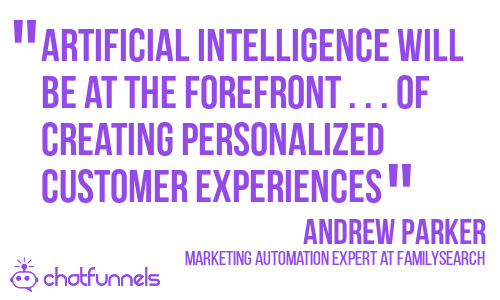
Well, the database folks are going to have to go into the database and run some algorithms and kind of spit out some scenarios. That’s really where it ultimately leads to with marketing automation and omnichannel is A.I., artificial intelligence will be the main forefront or at the forefront over the next 10 to 15 years of creating personalized customer experiences.
And that’s going to be driven by the database and then curated by the experience of marketing managers. Then it will all be delivered through some sort of marketing automation system. So marketing automation is essentially going to be the chassis that runs the customer experiences of the future. Everything will go through it. So if that’s the case all the different platforms out there going to have to learn how to connect into the various platforms, all the database platforms you’re going to have to be able to integrate quickly and easily.
And the marketing automation or just the marketing people, in general, are going to have to learn how to be experience creators and value adders more so than just advertisers. And I think that’s going to be an interesting challenge for the industry in the next 10 to 15 years.
Billy I think you’re spot on. But first, that data and how it’s structured and organized. I agree. A.I. is going to play a huge part, but the A.I. is only as good as that data. So we’re not going to get much better at organizing and structuring data than most of us are.
Andrew Exactly. And it’s hard work. Right. And being a database guy, you know, I grew up in that world. And so I had learned it on the fly. It’s gotten so complex now and so difficult. But it’s, but even just a basic knowledge of how databases work, how a sequel of the database works can work wonders for a good marketer, especially when they’re talking to the people who are no true database administrators.
Billy I agree. And then marketers become experienced managers that’s something we really try to do with the bots is create an experience in a chatbot. And it’s not just one bot. It could be ten bots that work in concept together to give the customer one experience which is ultimately to find out if you’re a good fit and then get you to buy. It needs to be helpful to you, not just a pop up that says “Just give us your e-mail”. We need to be smart about this. We need to provide a good experience. And when we have gone and looked into the data to say, OK, people that look at three Web pages as opposed to five, before booking a meeting are more likely to actually turn into a customer. Well, maybe. Let’s focus more on these first three Web pages they look at.
And be more proactive there and less proactive in the more pages they look at because they’re probably some type of tire kicker too early in the process. Well, I think you’re right. We’ve got to think more about how we provide a good experience for customers than just landing page- does it work or not?
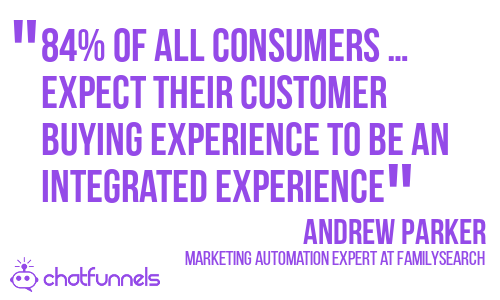
Andrew Now we could get away with that 15 or 20 years ago because everything was so new. But with the explosion of data here, we can’t do that anymore. Here’s a stat that’ll blow your mind. Marketo is one of the leading marketing automation platforms in the world. And they put out a 2018 study that basically said 84% of all consumers across all industries expect their customer buying experience to be an integrated experience.
So in other words, if they’re going to buy something, they expect the same experience online, in-store, in chat, on the phone, via text, via social, whatever it is, they expect that unified experience. And what was interesting about that is that while 84% of consumers expect that experience, it said something to the range of like 21% of businesses feel like they have an adequately cohesive experience. And I think the 21% are lying. If I’m being honest. The disparity is really there between the expectation and what’s really, what reality is.
Billy I think you’re right. I’ve given some business my e-mail address. If it was a brick and mortar businesses, I would kind of expect them to know who I am when I go in there. But they don’t. And most businesses, they’re trying to give this guy a lot of our customers this cohesive experience. But we’ve got all of these different tools and our tech stack and they don’t all talk to each other and communicate very well.
And so it is kind of a disjointed experience and we’re just doing the best we can at this point. So I want to know what tech stack does communicate well with each other and can put us on that road to the integrated experience.
Review of Tech Stacks
Andrew Yeah for sure. So it depends on what you’re looking for and what kind of business you are. So let me just break it down in a couple of places. If you’re a larger business, maybe mid-sized or large, the enterprise size, there’s really no reason to do anything other than Marketo and Salesforce.
Those two platforms speak really well to each other, despite the fact that Salesforce owns two separate marketing automation platforms on their own sales, Marketing cloud and Pardot. They work just fine and they integrate with Salesforce just fine. But they don’t have kind of some of the robust feature set that a Marketo might have.
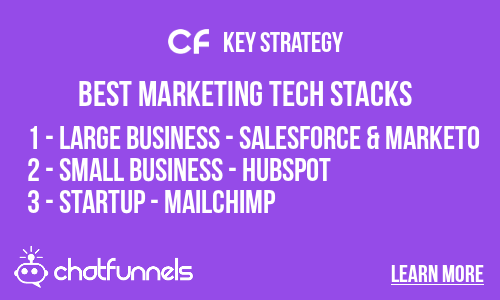
Just like a quick side note on the history here. Salesforce was at one point going to buy Marketo and then for whatever reason, that deal fell apart. And so Salesforce went out, bought ExactTarget, which they then made it to Salesforce Marketing Cloud. And then a few years later, they went out and bought Pardot, which essentially has the same functionality but brought it in-house. So they have Pardot, which they say is B2B functionality and then marketing cloud, which is B2C.
Reality is the functionality is still the same. So it’s just a different interface for both. Regardless if you’re in that large enterprise world, Marketo and Salesforce really makes a lot of sense. In terms of things like landing page creation and email creation and those kinds of things, you can do all that stuff in Marketo. But Marketo’s Creative Suite stinks.
Not too much to put too fine a point on it. And so I almost always encourage people to use something like lead pages or unbalance. Lead pages is what I use because it integrates seamlessly with Marketo and lead pages is like the world’s easiest tool to integrate with almost anything. And so when it comes to the landing pages, I usually use lead pages.
And then for email I use Hoosh. So those two really give me the flexibility to create and be a creative marketer and then also to integrate those really easily with Marketo. So that’s on the creative side, on the data side. I use Adobe Analytics because Marketo is an Adobe product. And those two things work super well together.
For all of my website traffic, I use WordPress for my Web site and I have some of the standard plug ins, that everybody uses. I have the Mozz plug in. I have, the 360 plugin that I cannot never remember the name of that one. But regardless WordPress plugs in really well to Marketo. They’ve got integration there. And so that’s really good.
And then as far as some other tech stack, just kind of add ons for fun. But there’s a couple of things that will help to evaluate your content.
Billy Oh, it’s a WordPress plugin?
Andrew It’s actually different. What should I call it? A Marketo plug in.
Billy Yeah. I’m not gonna be able to help you on that one. I know. Yoast is a WordPress one. I’ve used. It’s pretty good.
Andrew Yoast is the one that I typically like to use. There’s a plug in wants to look at Marketo. On the email deliverability side I tend to look at two things. I tend to look at Return path, Return path as a really good way to kind of evaluate deliverability.
Although Marketo does a lot of that for you. And then the other thing, the other one that you could potentially look at in addition or in lieu of Return path, Return path can be a bit expensive. Is the Email on Acid?
Billy Email on Acid?
Andrew Email on Acid.
Billy Yeah, I like it.
Andrew And it’s actually a really nice little program. It’s really simple, very inexpensive. It’ll show you exactly what your e-mail looks like in every single platform. It handles your deliverability. So it maintains your IP deliverability and the quality of your IP and helps you to deal with spam, and spam returns and helps that feedback loop. So, there’s a lot of different benefits from having Email on Acid. And then off to what I was thinking about earlier. Vid yard.
Billy Vid yard. Yeah, vid yard’s great.
Andrew It’s great. And they integrate directly with Marketo for your video marketing, which is a big deal these days. And then two others that I might just encourage you to take a look at. One is Ring Lead. That’s for your D tubing thing. And making sure that your database keeps, it stays clean. And then the last one I might. I got probably one more or two.
The other one that I might look at is called PFL. PFL is a direct mail house out of Montana, but they integrate directly with Marketo. So you can actually just say I want to send a direct mail campaign to these people. And if you have their address, you just press the button and they send it out and it shows up in people’s mailbox, like a couple of days later. So you can actually time emails and direct mails together.
Billy That’s awesome.
Andrew Which is super cool. And make it the kind of that, about omni channel kind of look at things. And then the last one I might take a look at is a Conversica. Conversica is essentially, they use A.I. to interpret responses, and I’m sure you guys are familiar with Conversica.
And I really like it. It integrates directly with Marketo, makes things easy. And so I think that’s a good thing to have for when you’re kind of evaluating some of those natural language and customer experiences. So those are the main tech stack. If you’re looking for something for maybe a smaller business or something more like a Soho or a startup.
So down on the complete other end of the scale, really, Mailchimp is your best bet.It’s cheap, it’s easy. They do landing pages, emails, automations. You can do everything in Mailchimp. So if you’ve got a limited budget of 200 bucks a month, get Mailchimp. You don’t need to do anything else.
And then for some of the smaller businesses, maybe 20 to 50 employees. I always look at HubSpot and how HubSpot is really good for smaller companies where you’re just going to do some email sequences and some landing page integration with your Google AdWords and your Facebook and that kind of stuff. Maybe you don’t have a ton of different channels. HubSpot can really handle two or three channels, but they are pretty thin. If you want a depth of customer experience, you’re going to go with Marketo and a large tech stack.
Billy This is this is good stuff, man. Really useful. OK. Well, I think we’ve about run out of time, but dude awesome insights and anyone that’s looking to learn more. How do they get a hold of you, professor?
Andrew Yeah, you bet. You can follow me on Twitter at Andrew R. Parker or you can email me anytime. It’s arparker@familysearch.org.
Billy Awesome. Well, thank you so much, Andrew. And until next time, keep it legit man. We’ll talk later.
Andrew OK. Thanks so much.
